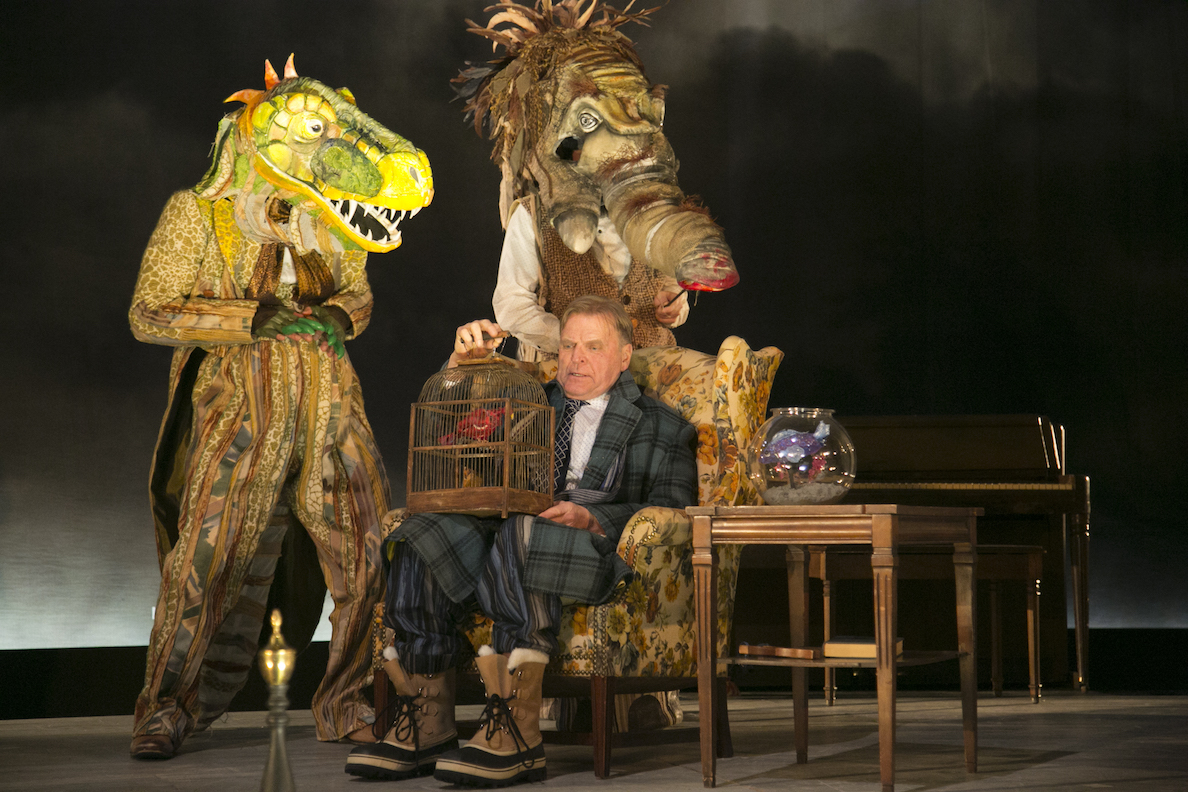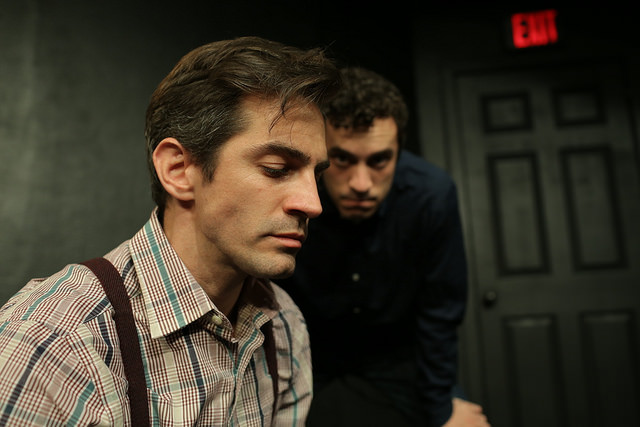

by JK Clarke
Humankind has been plagued with apocalyptic visions and foreboding since the dawn of civilization. Earliest organized groups of humans created mythologies (eventually called religion) designed to address and possibly face fears of the unknown. In the modern era, art is chiefly used as a coping mechanism for these fears. Thornton Wilder’s The Skin of Our Teeth—now playing through March 19 at Theatre for a New Audience’s (TFANA) Polonsky Shakespeare Center—is a perfect example of this, for it was written in a time of enormous uncertainty, 1942, when World War II’s rages had just replaced the desperation of the Great Depression. TFANA’s revival—the first in New York since 1998—under the direction of Arin Arbus, is a cry in the dark from a populace suddenly faced with uncertainty: societal, environmental, geo-political and existential. We have never been emotionally closer to 1942 in the intervening 75 years, so the timing couldn’t be better.
There’s no simple way to summarize the play, as it is deliberately disjointed, surreal and circular. Often compared to (and accused of borrowing from) Joyce’s Finnegan’s Wake, The Skin of Our Teeth follows the suburban New Jersey Antrobus family. Their apparent wedge of normalcy is the only recognizable part of the play: news updates on a video screen tell of a wall of ice moving south at a rapid pace. Society is in chaos, at the hands of an impending ice age. But the Antrobuses try to proceed as normal. Mr. Antrobus (David Rasche) is at work in the city where he apparently invents remarkably useful devices—like the wheel! (for a bit of surreal flair)—as his family eagerly and cautiously await his return home: like everything in the play, he’s unpredictable, emotionally and mentally. The family maid, Sabina (craftily and amusingly played by Mary Wiseman), sweeps the floor (poorly) and talks a blue streak, often stopping to address the audience directly, often discussing the play itself, thus breaking not only the fourth wall, but a few windows along the way: “I hate this play and every word in it. As for me, I don’t understand a single word of it anyway . . .”


As we begin to meet the family (whose pets are a musical duo who happen to be a piano- and guitar- playing dinosaur and mammoth), the veneer of the American dream begins to strip away: son Henry, we learn, has killed his brother (in a thinly veiled Biblical reference); Mrs. Antrobus (a tiger-like Kecia Lewis) is full of rage but resigned to her husband’s shortcomings; and Mr. Antrobus jeopardizes his family’s well-being and limited resources by inviting starving, freezing refugees (who are responsible for making this production’s cast 35 strong) into his home and instructs his wife and maid to feed them.
Though The Skin of Our Teeth has three distinct acts, Arbus provides only one intermission (at the end of Act II), so Act I ends and the next begins after a curtain is pulled on an ensemble song (written for this production by Cesar Alvarez) led by Lewis, “There’s Only What I Know,” which telegraphs their longing, “So many years I have been dreaming, dreaming/of a place on earth to call my own.” But when Act II opens, it’s an untold number of years later and we are in sunny Atlantic City and Mr. Antrobus is now president of the Ancient and Honorable Order of Mammals, Subdivision of Humans, this group having won some sort of battle over other creatures. Good times. It’s a harlequin atmosphere, with circus-like, roaring 20s burlesque characters dancing all over the Boardwalk. Sabina is there, but she’s a beauty queen, scheming to seduce the president.


But like the bad times, this moment too must pass—isn’t that the message after all?—and dire warnings of tumultuous storms come from a Fortune Teller (Mary Lou Rosato) who foresees, correctly, Antrobus rescuing animals from the flood two by two, à la Noah and his Ark.
After intermission, Act III opens in chaos by breaking the continuity of the play apart with an interruption from the “director” who announces that several cast members who were to perform a pivotal scene have become suddenly ill with food poisoning. Apologizing, he finds crew members who’ve remembered lines. It’s an absurd bit that might have astounded audiences in 1942, but has lost its power since, as experimental theaters have crossed far greater boundaries, rendering this transgression rather meek. Intentionally or not, it disrupts the play’s pace such that when we re-visit the Antrobuses again at their family home following a long, brutal war, it’s difficult to care about them any longer.


Relevance is the key here. Thornton’s work, remarkable for its time, only holds up in parts. The first act is easier to connect to: stories of hard times, helping refugees and a longing for a better life. But it’s harder for an audience to relate to the remainder of the play, despite the ascension of the unlikely character to the “presidency.” But that, too, could be because Wilder predicts so many cycles of doom and gloom, thus eliding Hope and visions of “normalcy.”
Arbus and the cast do a remarkable job of presenting characters faced with radically different life scenarios in a parade of the human comedy. Cait O’Connor’s gorgeous costume and puppet design are the centerpiece of the production, frequently injecting a lively and droll spirit into a play as bleak as any Pirandello, Ionesco or Beckett piece. Good times follow bad which return to good . . . and so on. The Skin of Our Teeth is fodder for deep reflection, and though harder to relate to in a modern era, still lays before us an often painful universal truth.
The Skin of Our Teeth. Through March 19 at Theatre for a New Audience’s Polonsky Shakespeare Center (262 Ashland Place, Brooklyn). www.TFANA.org
Photos: Gerry Goodstein






















